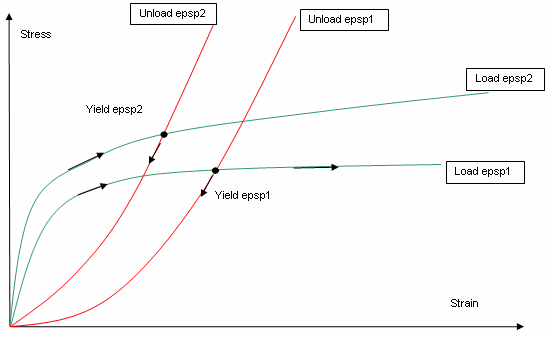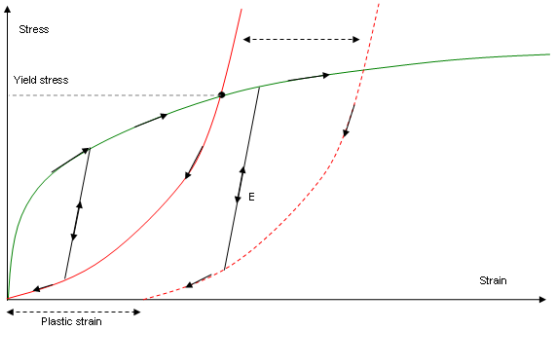MATX65 |

|

|

|

|
|
MATX65 |

|

|

|

|
Bulk Data Entry
MATX65 – Material Property Extension for Tabulated Strain Rate Dependent Elastic-Plastic Material for Geometric Nonlinear Analysis
Description
Defines additional material properties for tabulated strain rate dependent elastic-plastic material for geometric nonlinear analysis.
Format
(1) |
(2) |
(3) |
(4) |
(5) |
(6) |
(7) |
(8) |
(9) |
(10) |
MATX65 |
MID |
EPSMAX |
FSMOOTH |
FCUT |
NLOAD |
|
|
|
|
If NLOAD > 1, NLOAD times
|
TIDL |
TIDU |
EPSR |
FSCAL |
|
|
|
|
|
|
Field |
Contents |
MID |
Material ID of the associated MAT1 (See comment 1). No default (Integer > 0) |
EPSMAX |
Failure plastic strain εmax (Real > 0) |
FSMOOTH |
Strain rate filtering flag. Default = OFF (ON or OFF) |
FCUT |
Cutoff frequency for strain rate filtering. Default = 1.E30 (Real > 0) |
NLOAD |
Number of loading/unloading stress-strain function pairs. Default = 0 (Integer > 0) |
TIDL |
Identification number of TABLES1 entry that defines the loading stress-strain function. (Integer > 0) |
TIDU |
Identification number of TABLES1 entry that defines the unloading stress-strain function. (Integer > 0) |
EPSR |
Strain rate. Default = 1.0 (Real) |
FSCAL |
Scale factor for stress. Default = 1.0 (Real) |
| 1. | The material identification number must be that of an existing MAT1 bulk data entry. Only one MATXi material extension can be associated with a particular MAT1. |
| 2. | MATX65 is only applied in geometric nonlinear analysis subcases which are defined by ANALYSIS = EXPDYN. It is ignored for all other subcases. |
| 3. | The material law is defined by pairs of stress functions for loading and unloading at a constant strain rate. For each strain rate, the yield stress is defined by the intersection between loading and unloading curves. Unloading follows unloading curve shifted by plastic strain value. Strain rates are interpolated using input values. In the elastic range, stress smaller than the yield value, the material behavior is elastic with hysteresis. It is limited by loading and unloading curves. |

Loading and unloading function sets for constant strain rates.
The Young's modulus must be greater than the maximum function slopes, and is used to follow loading and unloading paths between limiting curves.

For a constant strain rate, user defined functions set the limits for the cycling loading.
| 4. | This card is represented as a material in HyperMesh. |
See Also: